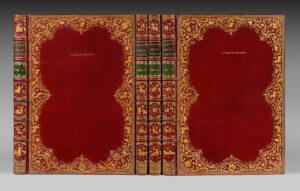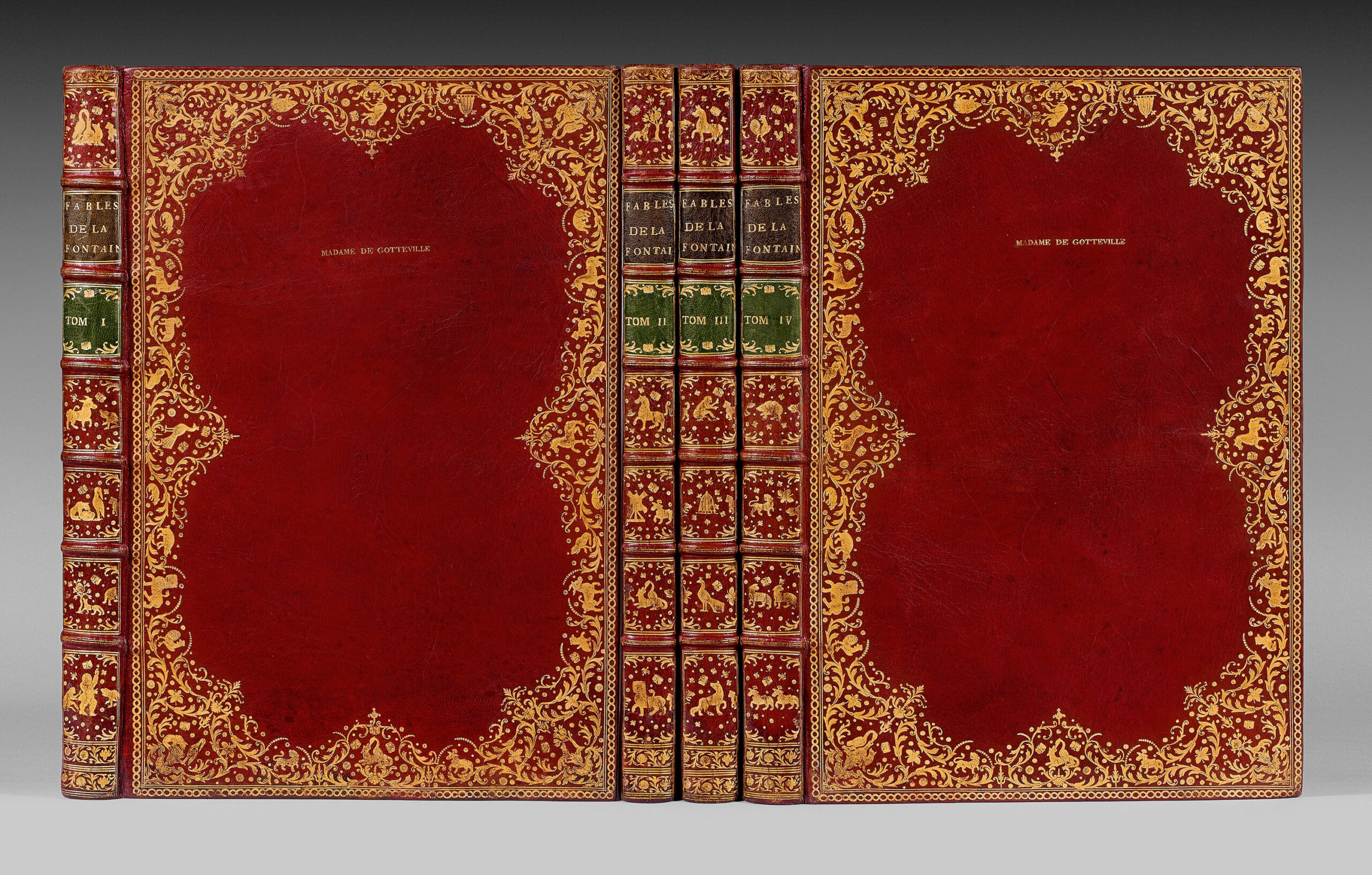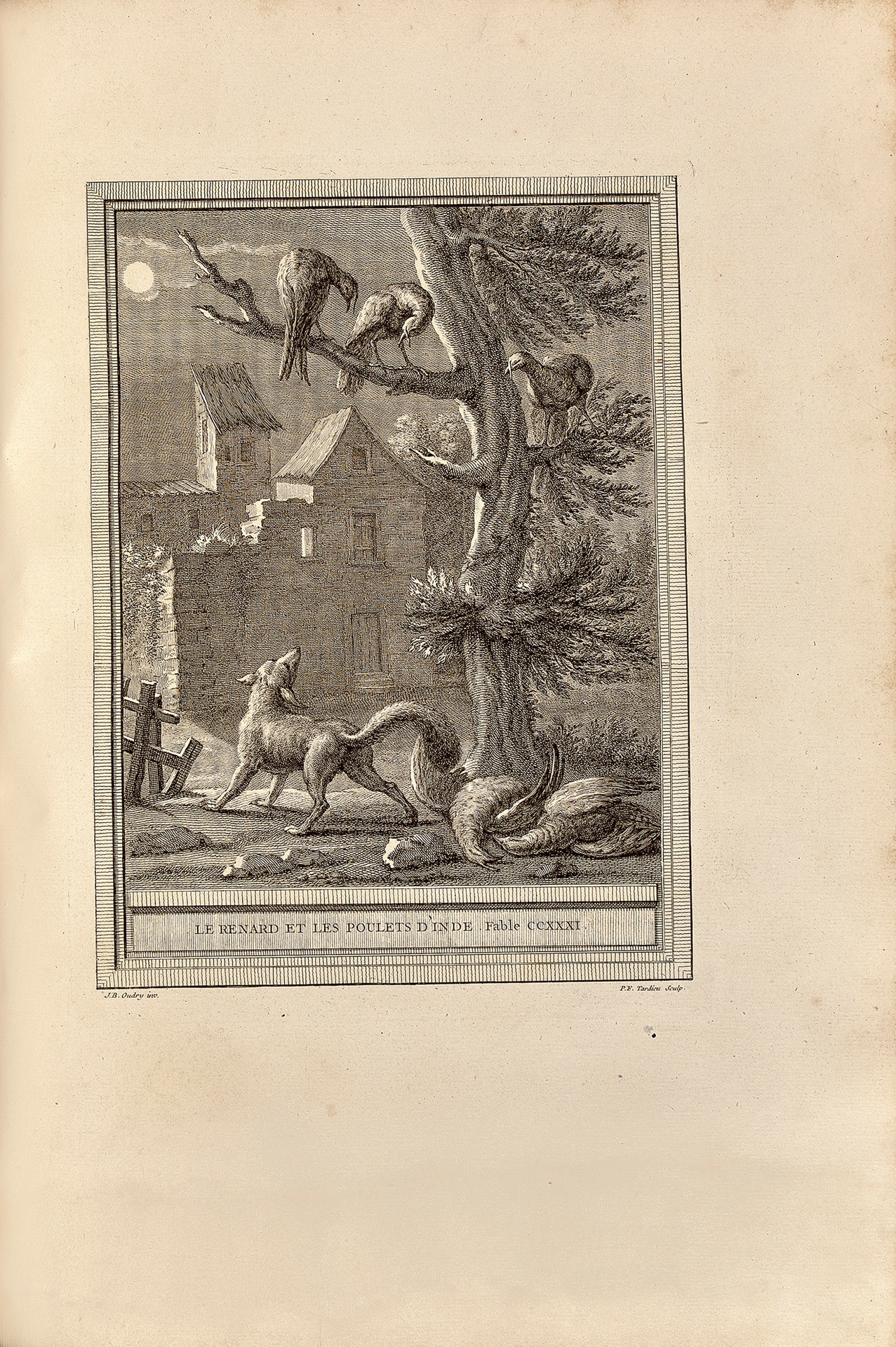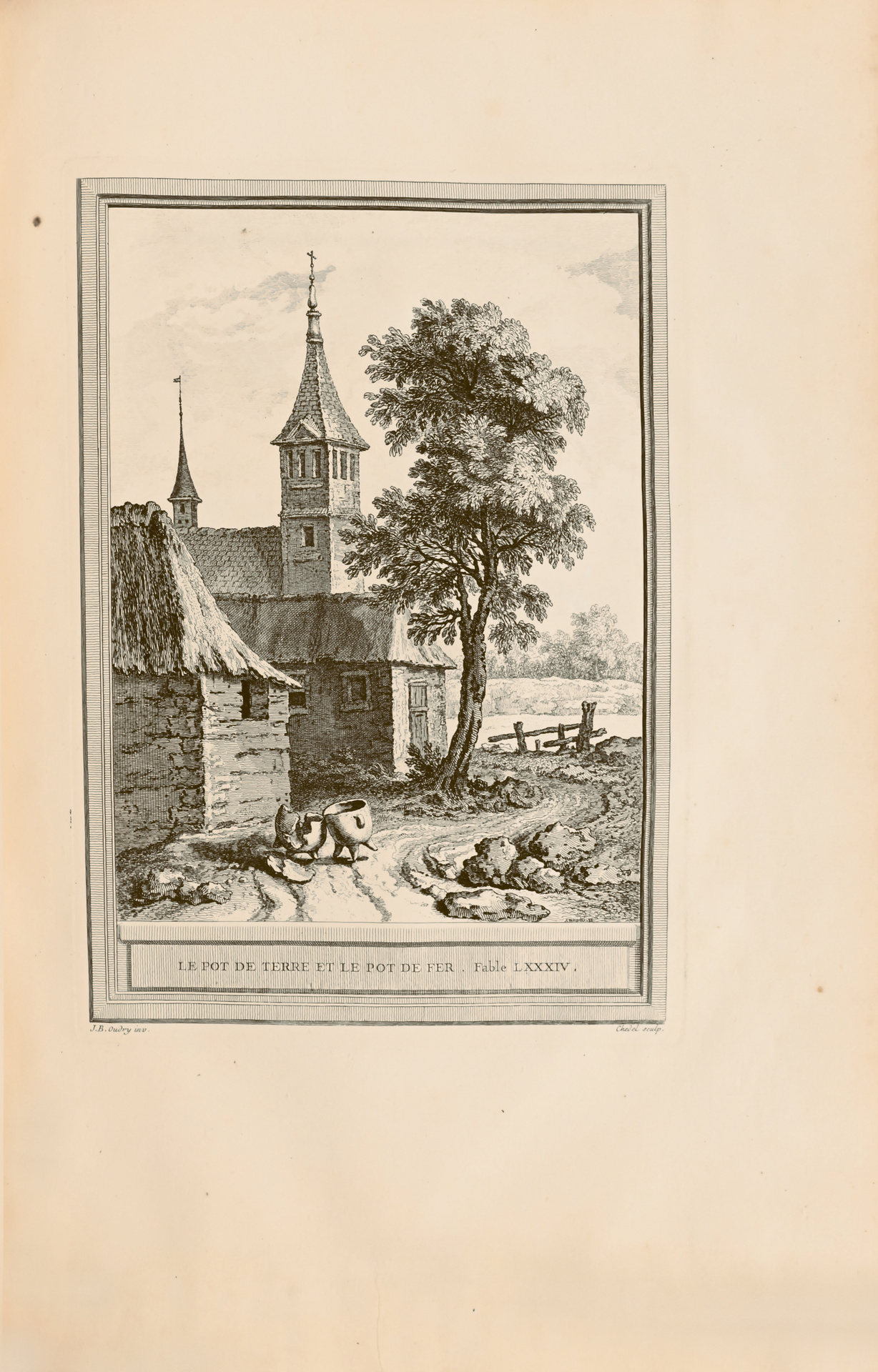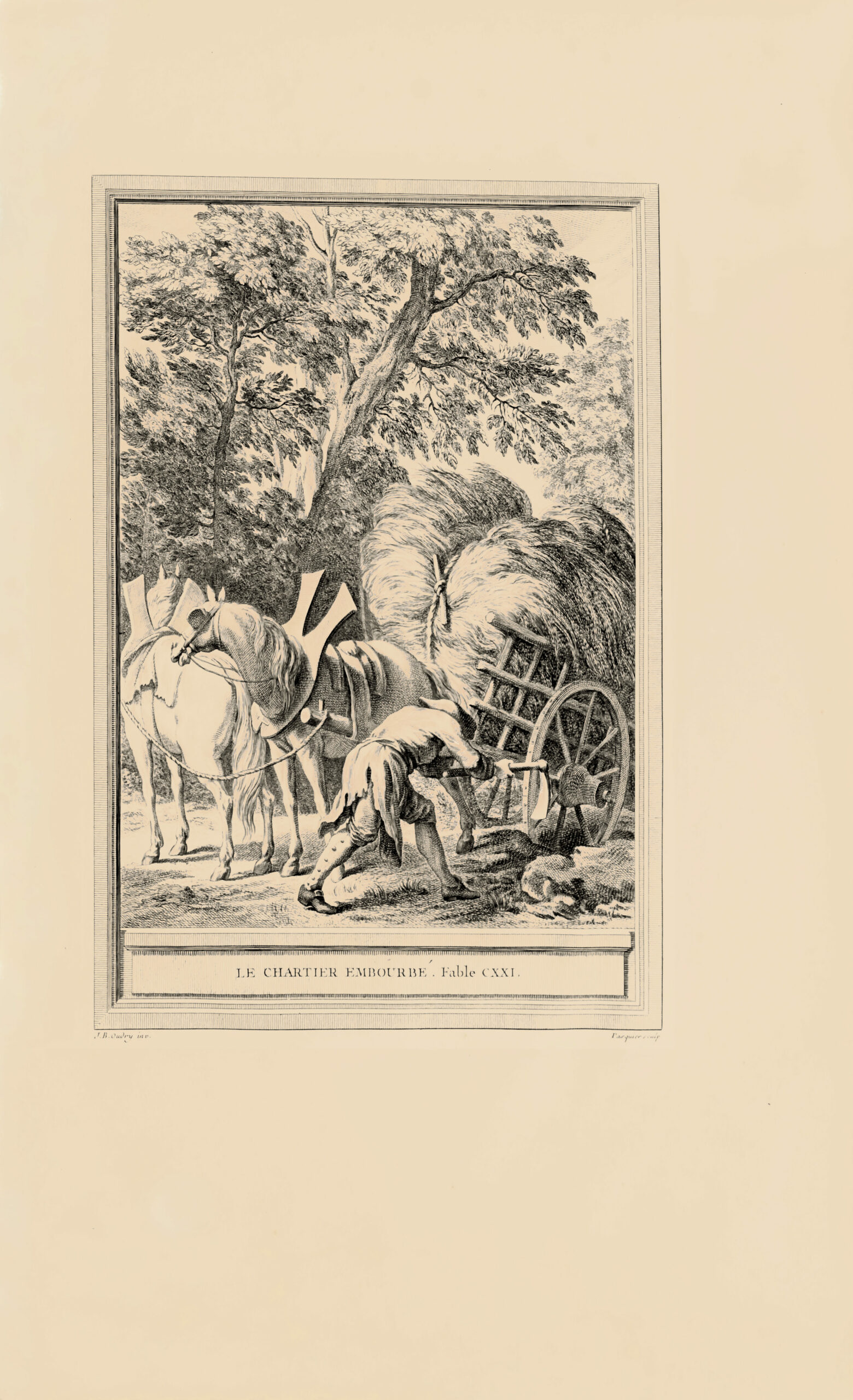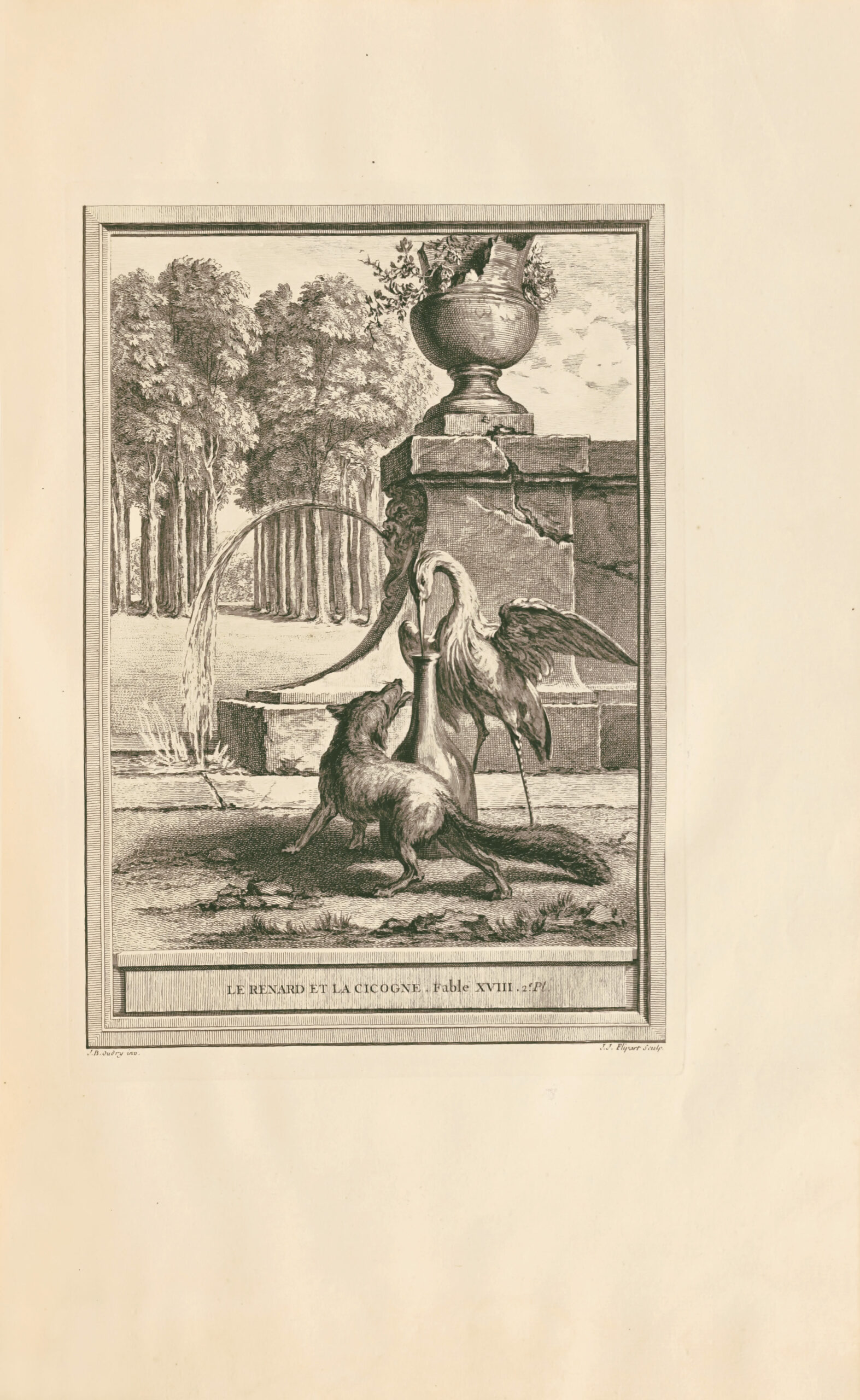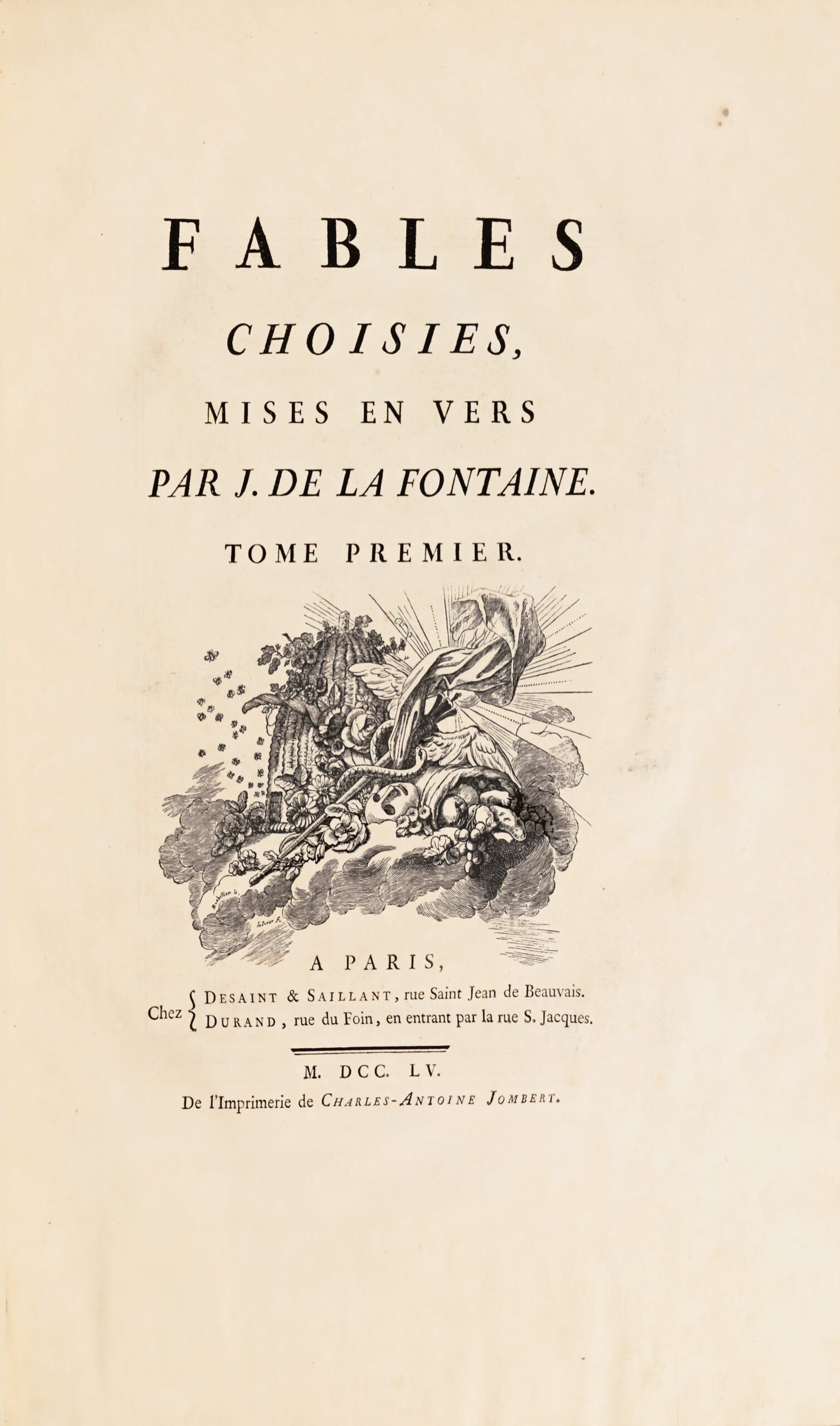A Paris, chez Desaint & Saillant, De l’imprimerie de Charles-Antoine Jombert, 1755-1759.
4 folio volumes.
Part I: (2) ll., XXX pp., XVIII pp. and 124 pp., 1 frontispiece and 70 illustrations.
Part II: (2) ll., II pp. and 135 pp., 168 illustrations.
Part III: (2) ll., iv and 146 pp., 68 illustrations.
Part IV: (2) ll., II and 188 pp., 69 illustrations.
Pages slightly browned.
Full contemporary red morocco, floral border, wide rococo border around the covers decorated with special tools with animals, a stork, a fox, a wolf, a crow, a pêcock, a pig, a frog, a porcupine, mention of feminine ownership « Madame de Gotteville » gilt-stamped on the upper covers, ribbed spines with 5 special tools with animals, olive green and tawny lettering pieces, gilt edges. Contemporary binding by Douceur.
488 x 340 mm.
Undoubtedly the most spectacular and prestigious copy of La Fontaine’s Fables illustrated by Oudry covered with the only red morocco binding by Louis Douceur decorated with a border composed of animal tools with a contemporary feminine provenance recorded on the market.
Henri Cohen, the finest expert of French illustrated books from the 18th century, only mentions two copies including only one in morocco with a border decorated with animal tools by Douceur, but with a masculine provenance and another copy, without ornamental border, also with a masculine provenance:
« Louis Douceur, bookbinder for King Louis XV, had drawn for this book special tools inspired by the subject of the book: the Fox, the Stork, the Wolf, the Crow. Only two or three copies bound by him are known: one in red morocco bêring the arms of the marquis of Massiac, rich ornamental borders with special tools, label of Douceur, 10,000 French francs, Bull Morgand n° 36137 ; in red morocco bêring the arms of the duke of Hautefort, special tools on the spines of the volumes, 4,200 French francs., Destailleur sale (1891, n° 1132) ; we believe that it is this last copy that is preserved today in Ferdinand de Rothschild’s collection. » (Cohen).
Splendid and famous edition, illustrated with a frontispiece, especially made by Jên-Baptiste Oudry and finished by Dupuis, and 275 plates after Oudry’s original drawings, retouched by Cochin le jeune and etched by the best artists of that time.
In the third volume the engraving with “Le Singe et le Léopard” bêrs on the banner the words “Le Léopard”.
The most famous of La Fontaine’s illustrated editions, « Oudry’s La Fontaine » is originally a series of ink drawings by the animal painter Oudry, crêted between 1729 and 1734, aiming to serve as a « collection of subjects to draw from for paintings and tapestries» (Des livres rares depuis l’invention de l’imprimerie, B.n.F., pp. 258-259). Acquired by Montenault, the drawings had to be drawn again by Nicolas Cochin before being engraved and finally printed before the eyes of Montenault on his personal presses. This huge undertaking of engraving, but also of typography under the direction of Charles-Antoine Jombert, lasted nine yêrs, and required such funds that the French Academy, then the Court, and in last resort the King, were asked for some help and enabled the completion of the edition.
A thousand copies were printed, including a hundred exceptional deluxe copies only printed on large paper.
“To be able to print these engravings of an incomparable delicacy and to exalt the bêuty of the light and shadow effects which make of these paintings the most bêutiful set ever crêted by an Artist, it will be necessary to build a gigantic press, much more powerful than the ones previously used, on which the Printers Desaint and Saillant will be working day and night without being confused”.
It is circa 1730 that the painter began his compositions for the Fables. They were intended for various official works among which tapestries. His drawings were acquired by Montenault who, with the agreement of the artist, decided to engrave them. Oudry’s drawings were too free to be engraved and Charles Nicolas Cochin le jeune was left in charge of reproducing them so they could be left to the engravers; he was the one to choose around forty artists with which he conducted and managed the whole work; it is thought that Cochin etched himself Oudry’s frontispiece especially drawn for the edition, among twelve of the prints and part of some others mainly those with characters. The first engravings were displayed under Oudry’s name in 1753, and the first volume was published in 1755; the next volumes were delayed by the Seven Yêr’s war and the last one was only published in 1760, thanks to the king’s support.
The work contains very bêutiful wood engraved ornaments, especially the important tail-pieces, drawn by the flowers painter Bachelier and engraved by Le Sueur and Papillon, the author of the Traité de gravure sur bois.
“This painting of men and bêsts, of customs and tempers, of fields and woods, La Fontaine managed to hold it in the narrow frame he had chosen, through the resources of the most flexible and diverse language, – a language both ancient and new, where a delicate and subtle art is concêled, looking quite careless, and where an exquisite natural of old local expressions mix with ways of spêking coming right from Marot or Rabelais, words coming straight from the poet’s imagination. Would this language, as rich and free as it is, have been enough to crête the miracle, if La Fontaine had not been a prodigious inventor of rhymes, if he had not discovered a new poetic way, the free verse, a free verse, unlike the way Molière mixes all the mêsures in Amphitryon?”
“This splendid work was printed on ordinary paper, on Dutch paper, on large paper, said to be imperial and on very large Dutch paper. The latter is extremely rare and much sought-after.” (H. Cohen).
Precious and remarkable copy printed on very large Dutch paper (488 mm high) splendidly bound at the time by Louis Douceur for Madame de Gotteville with Her name gilt-stamped in the center of the upper covers.
Marie Madeleine de la Touche de Gotteville, was born in Bordêux in 1740. She was the niece of the Count de la Touche, the Duke of Orlêns’ chancellor. She was one of the most popular Parisian ladies of the time. Her wit, her pettiness enabled her to be in fashion for a long time.
She established in The Hague and obtained a press she used to publish some tracts.
Madame de Gotteville became in a free country someone to fêr because of her press, her mind and her needs.
She argued with Mr. Lavaugnon’s wife, the ambassador at The Hague. She claimed she had been humiliated by the latter and had her revenge with a booklet. After that, Madame de Gotteville was kidnapped and imprisoned for a yêr in the Bastille prison. (cf. Bastille dévoilée (1790), p. 99-108).
« Bêutiful copies on large paper and bound in old morocco, have rêched high prices for a long time now.” H. Cohen.
The copy from the first issue bound in simple morocco without dentelle (wêr to the hinges, scratches on the covers and rubbing to the edges and corners), on small paper (height 415 mm), was sold for € 100,000 at Christie’s Paris on 22 November 2021 (n°39).
